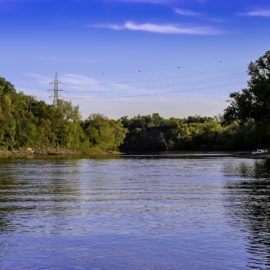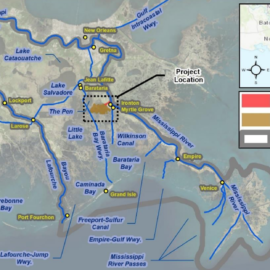

(Google Earth)
The money holders seem to be ready to approve the $2.26 Billion for the Mid-Barataria Diversion.
The federal and state trustees holding the purse strings for an unprecedented diversion project to help rebuild Louisiana’s disappearing coast released a report Wednesday signaling they are likely to approve the plan that will cost as much as $2.26 billion. The project would be paid for with settlement money related to the 2010 BP Deepwater Horizon oil spill, overseen by the trustees. The new report on the Mid-Barataria Sediment Diversion is based in part on and released in conjunction with a final environmental impact statement on the project released this week by the Army Corps of Engineers. Like the Corps report, it also details the benefits and detriments of the project that would funnel up to 75,000 cubic feet per second of water and sediment from the Mississippi River into the Barataria Basin to build new wetlands in Plaquemines and Jefferson parishes. But unlike the Corps report, the trustees’ version is focused specifically on how the project will restore damages made by the BP oil spill in the Barataria Basin, both directly through oiling of wetlands like those along Bay Jimmy that led to their disappearance, and indirectly through impacts on fisheries, birds and other natural resources that were damaged by the spill throughout the Gulf of Mexico. The trustee study concludes that the benefits of the diversion – the potential to add 21 square miles of new wetlands in the basin by 2070 and improve living conditions for a variety of wildlife types – more than outweigh the detrimental effects, including expected reductions in commercial fishery catches of oysters, brown shrimp and some finfish, and the death of hundreds of bottlenose dolphins due to the large-scale introduction of fresh water. “The benefits would be significant and would primarily derive from the creation of thousands of acres of marsh that, with a steady supply of Mississippi River sediment, would be sustained over decades even in the face of rising sea levels and coastal erosion,” the report said.
nola.com

(Louisiana BP Trustee Implementation Group)
The Barataria Basin with nothing done will lose over 50% of the land.
The Barataria Basin will face a daunting loss of the majority of its remaining wetlands during the first 50 years of the project’s operation, due to continued subsidence and increasing levels of sea level rise. But at the end of that period, more than 20% of the basin’s remaining marsh will have been created or sustained by the diversion, the report concluded. “The trustees believe that a sediment diversion is the only way to achieve a self-sustaining marsh ecosystem in the Barataria Basin, ” the report said. State Coastal Protection and Restoration Authority officials point out that both the Corps and trustee studies are based on comparatively high estimates of sea level rise driven by global warming, and if efforts to reduce worldwide levels of greenhouse gases are successful during the project’s first 50 years, the amount of land it could generate would likely rise, and the amount of wetlands lost in the basin also would be less.

The Trustee group is a number of groups all with an interest in the Basin.
The Louisiana Trustee Implementation Group, which oversees use of $4 billion of BP natural resource money in the state, includes representatives of the federal Environmental Protection Agency, National Oceanic and Atmospheric Administration, U.S. Fish & Wildlife Service and the Natural Resources Conservation Service, and the state Coastal Protection and Restoration Authority, Department of Natural Resources, Department of Environmental Quality, Department of Wildlife and Fisheries, and the Louisiana Oil Spill Coordinator’s Office. The diversion must still gain Corps approval of two federal permits governing potential environmental risks from the project and agreement by the Corps that the diversion will not interfere with use of the Mississippi River by shipping or the federally sponsored hurricane levees at its location in Plaquemines Parish. The project must also be granted a coastal use permit by the state Department of Natural Resources. The trustees are required to determine that the project meets the goals of the post-spill natural resource assessment and environmental impact statement outlining damage caused by the oil spill, and how the damage should be mitigated.

(Louisiana BP Trustee Implementation Group)
The group found that what the diversion would do is what is needed to rebuild the land.
The spill damage assessment found that a combination of “marsh creation and ridge restoration plus a large-scale sediment diversion would provide the greatest level of benefits to injured wetlands, coastal, and nearshore habitats and to the large suite of injured resources that depend in their life cycle on productive and sustainable wetland habitats” in both the Barataria Basin and the broader northern Gulf of Mexico. Wednesday’s report confirms that the project meets those requirements recommended by the trustees, but a final record of decision will not be issued until late December, in coordination with the Corps’ expected Dec. 23 decision on its permits. The newly created marsh will benefit many fish and wildlife species in the basin, the report concluded, including red drum, largemouth bass, blue crab, white shrimp, Gulf menhaden and migratory waterfowl, which translates into benefits to recreational users. Those fishery resources also will act as food sources for wildlife offshore in the Gulf of Mexico, the report said, which again was a goal of the natural resource assessment.

(Louisiana BP Trustee Implementation Group)
The group acknowledged that there will be some ill consequences with the diversion.
The trustees said they also recognize that freshening the basin with Mississippi River water will damage some natural resources, but pointed out that the damage must be weighed in the context of 100 years of change in the Barataria Basin. The basin went from being dominated by freshwater, with sediment overtopping natural levees along the river, before modern flood control levees cut off that flow. That has been accompanied by decades of wetlands loss and saltwater intrusion that have resulted in more brackish and saltwater species dominating the area. “Reconnecting the river to the basin to restore an estuary that has been degrading and becoming more saline for almost a century will produce significant changes to current conditions in the Barataria Basin, which will negatively affect some of the species that currently reside in the basin,” the report said. “That reduction in salinity would negatively impact fish and wildlife species that rely on higher saline waters and have moved further into the estuary as salinities have increased due to the severed connection between the river and the basin. Key species that would be adversely affected include dolphins, brown shrimp, and oysters.”

(Louisiana BP Trustee Implementation Group)
The trustees also approved the states input to the funding equation.
The trustee report includes the state’s proposed $378 million mitigation plan and a plan for operating the diversion if it is approved. That plan calls for a background flow of about 5,000 cubic feet per second of water through a 2-mile-long spillway from the river at mile marker 61, near Myrtle Grove, into Barataria wetlands. When the river speed increases to 450,000 cubic feet per second at Belle Chasse, just upriver, the structure’s gates will be open and water will feed by gravity into the basin. The diversion gates are designed to allow as much as 75,000 cfs to flow into the channel when the river reaches 1 million cfs at Belle Chasse. The operation plan includes provisions to shut down the diversion gates in the event of a hazardous materials spill upriver, or for hurricanes or other unexpected events on the river. State officials also have committed to a comprehensive monitoring plan, aimed at helping it change operations if necessary.

(Louisiana BP Trustee Implementation Group)
The spillway has specific areas were the land will be rebuilt.
Construction of the spillway calls for using material dredged from its channel to create new wetlands in three patches on the northern and southern sides of the outfall in the basin. The report also outlines how the new land created by the diversion is likely to slightly reduce hurricane storm surges along west bank levees, and how some communities south of the diversion will see more numerous high tide days and increased flooding risk when the diversion is operating. Like the Corps environmental statement, the trustee plan weighed the effectiveness of a maximum 75,000 cfs diversion against several alternatives: A similar sized diversion with dredge-and-pump-built marsh terraces in the outflow area to increase capture of sediment, 50,000 cfs diversions with and without terraces and 150,000 cfs diversions with and without terraces. The terraces — designed to help hold sediment in place and assist in land building — were determined to not provide enough additional land for the extra cost involved.

(Louisiana Trustee Implementation Group)
They compared a smaller diversion as well as the one approved.
The smaller diversion was determined to produce too little land, though it would have a lesser effect on some commercial fishery species. The larger diversion would actually produce more land, but also would have a greater effect on commercial fisheries, and cost more.
Remember that public comments are being taken.



